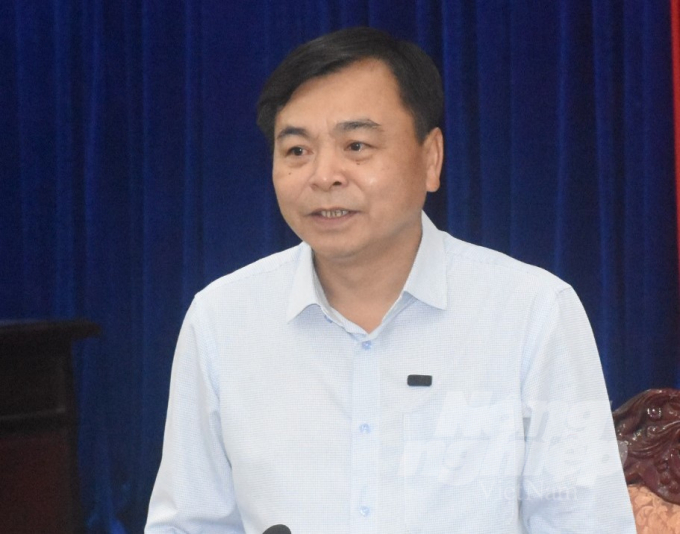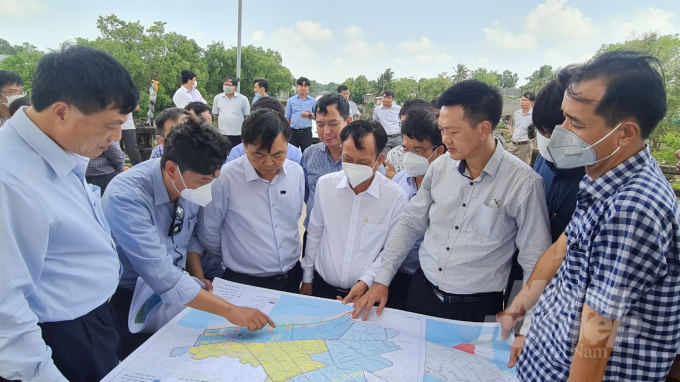November 24, 2025 | 12:32 GMT +7
November 24, 2025 | 12:32 GMT +7
Hotline: 0913.378.918
November 24, 2025 | 12:32 GMT +7
Hotline: 0913.378.918

Deputy Minister of Agriculture and Rural Development Nguyen Hoang Hiep and the delegation worked with the leaders of Bac Lieu province on public investment projects. Photo: Trong Linh.
"The water regulation and replenishment system for aquaculture of the South National Highway 1A (NH1A), Bac Lieu province" is considered a very important project for the socio-economic development of Bac Lieu in the 2022 - 2025 period. The project's beneficiary areas include a part of Bac Lieu city, Vinh Loi district, Hoa Binh district, Dong Hai district and Gia Rai town.
The project task is to transfer freshwater from the North of NH1A to the South of NH1A in order to dilute the water source so that aquaculture of the 46,300 ha can be secured. The project also assists in the salt washing process before the sowing period to serve rice cultivation in the 15,000 ha area transitioning to rice-shrimp models along the Ca Mau - Bac Lieu canal.
Irrigation works help enhance the ability to exchange water sources, actively remove polluted water, supply seawater of good quality, and contribute to reducing water pollution in the river and canal system in service of aquaculture.

Deputy Minister Nguyen Hoang Hiep and Chairman of Bac Lieu People's Committee Pham Van Thieu surveying localities. Photo: Trong Linh.
The project area, according to the investment policy approval decision, consists of two areas with different ecosystems separated by the Bac Lieu - Ca Mau canal.
According to specialized agencies and experts of the Ministry of Agriculture and Rural Development (MARD), the rice-shrimp model is an appropriate model in the context of climate change, and the southern region of Bac Lieu province possesses favorable conditions to develop this model. The problem is that without an irrigation system transporting water from the North of NH1A to the South of NH1A, it is completely impossible to apply rice-shrimp production in this area.
The immediate action is to spread the word so that people can get a full grasp of this project and its tasks. Some comments are still concerned about the quality of water brought to the South National Highway 1A because this area has many urban areas, including Bac Lieu city and Gia Rai town, which still discharge waste water. “Is there sufficient fresh water to supply the southern region while still serving the rice production area of North National Highway 1A?” and ”Besides, how effective is the anti-flooding system?” are questions that the localities frequently receive.
Chairman of Bac Lieu People's Committee Pham Van Thieu said, “This region currently lacks water regulation, supply and drainage works for production, leading to water shortage during the dry season. Freshwater from Hau river cannot be used to supply directly to the South NH1A. The freshwater source is mainly from the rainy season.”
Up to now, approximately 64,000 ha converted from cultivation of rice and other crops to brackish saltwater aquaculture lacks fresh water to supplement fisheries farming and improve water quality. Normally from December every year to June of the next year there is a shortage of 473 - 546 million m³ of required freshwater. This situation during the dry season severely affects aquaculture in the area and pollutes pond water, causing diseases to occur in 13- 27% of the farming area.
Deputy Minister Nguyen Hoang Hiep emphasized a fact that Bac Lieu has been assigned by the Prime Minister to become the center of the shrimp industry in Vietnam. But Bac Lieu needs good irrigation infrastructure to complete this goal.
“The soon-to-be-implemented project will help Bac Lieu become proactive in water sources for production in both the North and South of National Highway 1A. However, because there are still many different viewpoints regarding this matter, the MARD has to conduct more reality surveys, listen to the opinions of localities, professional agencies and scientists.”
The North National Highway 1A has a natural area of about 157,000 ha, currently producing crops in accordance with the freshwater ecosystem. The region’s freshwater source is mainly from the Hau River through the Quan Lo - Phung Hiep canal and the system of level 2 and 3 canals.
The South National Highway 1A has an estimated natural area of 110,000 ha, including 4,000 ha of protection forest outside the dyke. This region often facé difficulties in cultivation because of prolonged rain and high tide causing inundation.
Translated by Samuel Pham
/2025/11/22/4018-4-213342_747.jpg)
(VAN) The Mekong Delta Agricultural Experts Club has attracted 143 experts and researchers to participate in providing consultancy and contributing initiatives to the development of one million hectares of high-quality rice.

(VAN) Ca Mau’s development of OCOP products opens a path to increasing cooperatives value, helping boost income, expand markets, and affirm collective economy's role.

(VAN) Turning seemingly ordinary coconut shells into unique jewelry and artwork, Nguyen Bang Nhi spreads the value of local culture through her brand, Cocohand.

(VAN) Results from the Sustainable Durian Model Project in Dak Lak have confirmed the critical role of Yara Viet Nam in transferring advanced nutritional solutions to farmers.

(VAN) In Tuyen Quang province, livestock farmers have introduced effective models and innovative practices that significantly strengthen African Swine Fever prevention and control efforts.

(VAN) This is the study conducted by IRRI and Can Tho University on the rice straw value chain in Mekong Delta showing an economic potential of more than 6.6 trillion VND/year.

(VAN) By participating in cooperative economics, many farmers in Tay Ninh have overcome hardship, mastered clean dragon fruit cultivation techniques.